图形图像处理-之-任意角度的高质量的快速的图像旋转 中篇 高质量的旋转
图形图像处理-之-任意角度的高质量的快速的图像旋转 中篇 高质量的旋转 HouSisong@GMail.com 2007.06.26 (2009.03.09 可以到这里下载旋转算法的完整的可以编译的项目源代码: http://blog.csdn.net/housisong/archive/2009/03/09/39
图形图像处理-之-任意角度的高质量的快速的图像旋转 中篇 高质量的旋转
HouSisong@GMail.com 2007.06.26
(2009.03.09 可以到这里下载旋转算法的完整的可以编译的项目源代码: http://blog.csdn.net/housisong/archive/2009/03/09/3970925.aspx )
(2007.09.14 修正三次卷积的MMX版本中表的精度太低(7bit),造成卷积结果误差较大的问题,该版本提高了插值质量,并且速度加快约15-20%)
tag:图像旋转,任意角度,图像缩放,速度优化,定点数优化,近邻取样插值,二次线性插值,
三次卷积插值,MipMap链,三次线性插值,MMX/SSE优化,CPU缓存优化,AlphaBlend,颜色混合,并行
摘要:首先给出一个基本的图像旋转算法,然后一步一步的优化其速度和旋转质量,打破不能软件旋转的神话!
任意角度的高质量的快速的图像旋转 全文 分为:
上篇 纯软件的任意角度的快速旋转
中篇 高质量的旋转
下篇 补充话题(完整AlphaBlend旋转、旋转函数并行化、针对大图片的预读缓冲区优化)
正文:
为了便于讨论,这里只处理32bit的ARGB颜色;
代码使用C++;涉及到汇编优化的时候假定为x86平台;使用的编译器为vc2005;
为了代码的可读性,没有加入异常处理代码;
测试使用的CPU为AMD64x2 4200+(2.37G),测试时使用的单线程执行;
(一些基础代码和插值原理的详细说明参见作者的《图形图像处理-之-高质量的快速的图像缩放》系列文章
旋转原理和基础参考《图形图像处理-之-任意角度的高质量的快速的图像旋转 上篇 纯软件的任意角度的快速旋转》)
速度测试说明:
只测试内存数据到内存数据的缩放
测试图片都是800*600旋转到1004*1004,测试成绩取各个旋转角度的平均速度值; fps表示每秒钟的帧数,值越大表示函数越快
A:一些颜色和图片的数据定义:
typedef unsigned char TUInt8; // [0..255]
struct TARGB32 //32 bit color
{
TUInt8 b,g,r,a; //a is alpha
};
struct TPicRegion //一块颜色数据区的描述,便于参数传递
{
TARGB32* pdata; //颜色数据首地址
long byte_width; // 一行数据的物理宽度(字节宽度);
//abs(byte_width)有可能大于等于width*sizeof(TARGB32);
long width; //像素宽度
long height; //像素高度
};
inline TARGB32& Pixels(TARGB32* pcolor,const long byte_width,const long x,const long y)
{
return ( (TARGB32*)((TUInt8*)pcolor+byte_width* y) )[x];
}
//那么访问一个点的函数可以写为:
inline TARGB32& Pixels(const TPicRegion& pic,const long x,const long y)
{
return Pixels(pic.pdata,pic.byte_width,x,y);
}
//判断一个点是否在图片中
inline bool PixelsIsInPic(const TPicRegion& pic,const long x,const long y)
{
return ( (x>=0)&&(x<pic.width) && (y>=0)&&(y< pic.height) );
}
//访问一个点的函数,(x,y)坐标可能超出图片边界; //边界处理模式:边界饱和
inline TARGB32& Pixels_Bound(const TPicRegion& pic,long x,long y)
{
//assert((pic.width>0)&&(pic.height>0));
if (x<0) x=0; else if (x>=pic.width ) x=pic.width -1 ;
if (y<0) y=0; else if (y>=pic.height) y=pic.height-1 ;
return Pixels(pic,x,y);
}
inline TARGB32& Pixels_Bound(const TPicRegion& pic,long x,long y,bool& IsInPic)
{
//assert((pic.width>0)&&(pic.height>0));
IsInPic=true ;
if (x<0) {x=0; IsInPic=false; } else if (x>=pic.width ) {x=pic.width -1; IsInPic=false ; }
if (y<0) {y=0; IsInPic=false; } else if (y>=pic.height) {y=pic.height-1; IsInPic=false ; }
return Pixels(pic,x,y);
}
B:实现二次线性插值的旋转
(插值原理参见我的blog文章《图形图像处理-之-高质量的快速的图像缩放 中篇 二次线性插值和三次卷积插值》)
a.首先改写用于边界扫描的类TRotaryClipData;在图片边缘插值的时候,插值的颜色数据可能
部分在图片外,部分颜色数据在图片内,所以TRotaryClipData需要同时找出“插值边界以外”、
“插值边界”、“插值边界以内”
扫描线图示: 外 | 边界 | 内 | 边界 | 外
struct TRotaryClipData{
public :
long src_width;
long src_height;
long dst_width;
long dst_height;
long Ax_16;
long Ay_16;
long Bx_16;
long By_16;
long Cx_16;
long Cy_16;
long border_width;//插值边界宽度
private :
long cur_dst_up_x0;
long cur_dst_up_x1;
long cur_dst_down_x0;
long cur_dst_down_x1;
inline bool is_border_src(long src_x_16,long src_y_16)
{
return ( ( (src_x_16>=(-(border_width<<16)))&&((src_x_16>>16)<(src_width + border_width)) )
&& ( (src_y_16>=(-(border_width<<16)))&&((src_y_16>>16)<(src_height+ border_width)) ) );
}
inline bool is_in_src(long src_x_16,long src_y_16)
{
return ( ( (src_x_16>=(border_width<<16))&&((src_x_16>>16)<(src_width- border_width) ) )
&& ( (src_y_16>=(border_width<<16))&&((src_y_16>>16)<(src_height- border_width)) ) );
}
void find_begin_in(long dst_y,long& out_dst_x,long& src_x_16,long& src_y_16)
{
src_x_16-= Ax_16;
src_y_16-= Ay_16;
while (is_border_src(src_x_16,src_y_16))
{
-- out_dst_x;
src_x_16-= Ax_16;
src_y_16-= Ay_16;
}
src_x_16+= Ax_16;
src_y_16+= Ay_16;
}
bool find_begin(long dst_y,long& out_dst_x0,long dst_x1)
{
long test_dst_x0=out_dst_x0-1 ;
long src_x_16=Ax_16*test_dst_x0 + Bx_16*dst_y + Cx_16;
long src_y_16=Ay_16*test_dst_x0 + By_16*dst_y + Cy_16;
for (long i=test_dst_x0;i<=dst_x1;++ i)
{
if (is_border_src(src_x_16,src_y_16))
{
out_dst_x0= i;
if (i== test_dst_x0)
find_begin_in(dst_y,out_dst_x0,src_x_16,src_y_16);
if (out_dst_x0<0 )
{
src_x_16-=(Ax_16* out_dst_x0);
src_y_16-=(Ay_16* out_dst_x0);
}
out_src_x0_16= src_x_16;
out_src_y0_16= src_y_16;
return true ;
}
else
{
src_x_16 += Ax_16;
src_y_16+= Ay_16;
}
}
return false ;
}
void find_end(long dst_y,long dst_x0,long& out_dst_x1)
{
long test_dst_x1= out_dst_x1;
if (test_dst_x1<dst_x0) test_dst_x1= dst_x0;
long src_x_16=Ax_16*test_dst_x1 + Bx_16*dst_y + Cx_16;
long src_y_16=Ay_16*test_dst_x1 + By_16*dst_y + Cy_16;
if (is_border_src(src_x_16,src_y_16))
{
++ test_dst_x1;
src_x_16+= Ax_16;
src_y_16+= Ay_16;
while (is_border_src(src_x_16,src_y_16))
{
++ test_dst_x1;
src_x_16+= Ax_16;
src_y_16+= Ay_16;
}
out_dst_x1= test_dst_x1;
}
else
{
src_x_16 -= Ax_16;
src_y_16-= Ay_16;
while (! is_border_src(src_x_16,src_y_16))
{
-- test_dst_x1;
src_x_16-= Ax_16;
src_y_16-= Ay_16;
}
out_dst_x1= test_dst_x1;
}
}
inline void update_out_dst_x_in()
{
if ((0==border_width)||(out_dst_x0_boder>= out_dst_x1_boder) )
{
out_dst_x0_in= out_dst_x0_boder;
out_dst_x1_in= out_dst_x1_boder;
}
else
{
long src_x_16= out_src_x0_16;
long src_y_16= out_src_y0_16;
long i= out_dst_x0_boder;
while (i< out_dst_x1_boder)
{
if (is_in_src(src_x_16,src_y_16)) break ;
src_x_16+= Ax_16;
src_y_16+= Ay_16;
++ i;
}
out_dst_x0_in= i;
src_x_16=out_src_x0_16+(out_dst_x1_boder-out_dst_x0_boder)* Ax_16;
src_y_16=out_src_y0_16+(out_dst_x1_boder-out_dst_x0_boder)* Ay_16;
i= out_dst_x1_boder;
while (i> out_dst_x0_in)
{
src_x_16-= Ax_16;
src_y_16-= Ay_16;
if (is_in_src(src_x_16,src_y_16)) break ;
-- i;
}
out_dst_x1_in= i;
}
}
inline void update_out_dst_up_x()
{
if (cur_dst_up_x0<0 )
out_dst_x0_boder=0 ;
else
out_dst_x0_boder = cur_dst_up_x0;
if (cur_dst_up_x1>= dst_width)
out_dst_x1_boder= dst_width;
else
out_dst_x1_boder = cur_dst_up_x1;
update_out_dst_x_in();
}
inline void update_out_dst_down_x()
{
if (cur_dst_down_x0<0 )
out_dst_x0_boder=0 ;
else
out_dst_x0_boder = cur_dst_down_x0;
if (cur_dst_down_x1>= dst_width)
out_dst_x1_boder= dst_width;
else
out_dst_x1_boder = cur_dst_down_x1;
update_out_dst_x_in();
}
public :
long out_src_x0_16;
long out_src_y0_16;
long out_dst_up_y;
long out_dst_down_y;
long out_dst_x0_boder;
long out_dst_x0_in;
long out_dst_x1_in;
long out_dst_x1_boder;
public :
bool inti_clip(double move_x,double move_y,unsigned long aborder_width)
{
border_width= aborder_width;
//计算src中心点映射到dst后的坐标
out_dst_down_y=(long)(src_height*0.5+ move_y);
cur_dst_down_x0=(long)(src_width*0.5+ move_x);
cur_dst_down_x1= cur_dst_down_x0;
//得到初始扫描线
if (find_begin(out_dst_down_y,cur_dst_down_x0,cur_dst_down_x1))
find_end(out_dst_down_y,cur_dst_down_x0,cur_dst_down_x1);
out_dst_up_y= out_dst_down_y;
cur_dst_up_x0= cur_dst_down_x0;
cur_dst_up_x1= cur_dst_down_x1;
update_out_dst_up_x();
return (cur_dst_down_x0< cur_dst_down_x1);
}
bool next_clip_line_down()
{
++ out_dst_down_y;
if (!find_begin(out_dst_down_y,cur_dst_down_x0,cur_dst_down_x1)) return false ;
find_end(out_dst_down_y,cur_dst_down_x0,cur_dst_down_x1);
update_out_dst_down_x();
return (cur_dst_down_x0< cur_dst_down_x1);
}
bool next_clip_line_up()
{
-- out_dst_up_y;
if (!find_begin(out_dst_up_y,cur_dst_up_x0,cur_dst_up_x1)) return false ;
find_end(out_dst_up_y,cur_dst_up_x0,cur_dst_up_x1);
update_out_dst_up_x();
return (cur_dst_up_x0< cur_dst_up_x1);
}
};
b. 边界插值的特殊处理
对于“插值边界以外”很简单,不用处理直接跳过插值;
对于“插值边界以内”,也比较容易处理,直接调用快速的差值算法就可以了,不用担心内存访问问题;
插值实现:
(从《图形图像处理-之-高质量的快速的图像缩放 中篇 二次线性插值和三次卷积插值》文章来的,后面不再说明)
{
TARGB32* PColor0=&Pixels(pic,x_16>>16,y_16>>16 );
TARGB32* PColor1=(TARGB32*)((TUInt8*)PColor0+ pic.byte_width);
unsigned long u_8=(unsigned char)(x_16>>8 );
unsigned long v_8=(unsigned char)(y_16>>8 );
unsigned long pm3_8=(u_8*v_8)>>8 ;
unsigned long pm2_8=u_8- pm3_8;
unsigned long pm1_8=v_8- pm3_8;
unsigned long pm0_8=256-pm1_8-pm2_8- pm3_8;
unsigned long Color=*(unsigned long* )(PColor0);
unsigned long BR=(Color & 0x00FF00FF)* pm0_8;
unsigned long GA=((Color & 0xFF00FF00)>>8)* pm0_8;
Color=((unsigned long*)(PColor0))[1 ];
GA+=((Color & 0xFF00FF00)>>8)* pm2_8;
BR+=(Color & 0x00FF00FF)* pm2_8;
Color=*(unsigned long* )(PColor1);
GA+=((Color & 0xFF00FF00)>>8)* pm1_8;
BR+=(Color & 0x00FF00FF)* pm1_8;
Color=((unsigned long*)(PColor1))[1 ];
GA+=((Color & 0xFF00FF00)>>8)* pm3_8;
BR+=(Color & 0x00FF00FF)* pm3_8;
*(unsigned long*)result=(GA & 0xFF00FF00)|((BR & 0xFF00FF00)>>8 );
}
对于“插值边界”,就需要特殊处理了,很多插值旋转的实现可能都在这里打了折扣;要想完美的解决
这块区域,可以引入AlphaBlend(带Alpha通道的颜色混合) ;
其实AlphaBlend的原理也很简单,就是按不同的比例混合两种颜色:
new_color=dst_color*(1-alpha)+src_color*alpha;
对于ARGB32bit颜色,需要用该公式分别处理4个颜色通道,并假设Alpha为[0..255]的整数,那么完整的实现函数为:
{
// AlphaBlend颜色混合公式(对其中的每个颜色分量分别处理):
// new_color=(dst_color*(255-src_color.alpha)+src_color*src_color.alpha)/255
//提示:除法指令是很慢的操作,但vc2005可以把x/255编译为完全等价的"(x*M)>>N"类似的快速计算代码;
unsigned long a= src.a;
// if (a==0) return dst;
//else if (a==255) return src;
unsigned long ra=255- a;
unsigned long result_b=(dst.b*ra+src.b*a)/255 ;
unsigned long result_g=(dst.g*ra+src.g*a)/255 ;
unsigned long result_r=(dst.r*ra+src.r*a)/255 ;
unsigned long result_a=(dst.a*ra+a*a)/255 ;
unsigned long result=(result_b) | (result_g<<8) | (result_r<<16) | (result_a<<24 );
return *(TARGB32*)& result;
}
优化AlphaBlend,颜色处理中,也可以这样近似计算: x/255 => x>>8 ,所以有:
{
unsigned long a= src.a;
unsigned long ra=255- a;
unsigned long result_b=(dst.b*ra+src.b*a)>>8 ;
unsigned long result_g=(dst.g*ra+src.g*a)>>8 ;
unsigned long result_r=(dst.r*ra+src.r*a)>>8 ;
unsigned long result_a=(dst.a*ra+a*a)>>8 ;
unsigned long result=(result_b) | (result_g<<8) | (result_r<<16) | (result_a<<24 );
return *(TARGB32*)& result;
}
(dst*(255-alpha)+src*alpha)>>8 可以近似为:(dst*(256-alpha)+src*alpha)>>8
即 (dst<<8+(src-dst)*alpha)>>8 从而用一个移位代替一个乘法 (*256会被优化为移位)
{
long a= src.a;
unsigned long result_b=((unsigned long)(((long)dst.b)*256+((long)src.b-(long)dst.b)*a))>>8 ;
unsigned long result_g=((unsigned long)(((long)dst.g)*256+((long)src.g-(long)dst.g)*a))>>8 ;
unsigned long result_r=((unsigned long)(((long)dst.r)*256+((long)src.r-(long)dst.r)*a))>>8 ;
unsigned long result_a=((unsigned long)(((long)dst.a)*256+((long)a-(long)dst.a)*a))>>8 ;
unsigned long result=(result_b) | (result_g<<8) | (result_r<<16) | (result_a<<24 );
return *(TARGB32*)& result;
}
继续优化,同时运算两路颜色分量的AlphaBlend实现:
{
unsigned long Src_ARGB=*(unsigned long*)& src;
unsigned long Dst_ARGB=*(unsigned long*)& dst;
unsigned long a=Src_ARGB>>24 ;
unsigned long ra=255- a;
unsigned long result_RB=((Dst_ARGB & 0x00FF00FF)*ra + (Src_ARGB & 0x00FF00FF)* a);
unsigned long result_AG=(((Dst_ARGB & 0xFF00FF00)>>8)*ra + ((Src_ARGB & 0xFF00FF00)>>8)* a);
unsigned long result=((result_RB & 0xFF00FF00)>>8) | (result_AG & 0xFF00FF00 );
return *(TARGB32*)& result;
}
回到我们的主线:完美解决“旋转插值边界”
怎么利用AlphaBlend呢? 我们可以在处理边界的时候,对于颜色数据在图片内的颜色,把Alpha通道分量设置为255,
在图片外的颜色数据(使用Pixels_Bound会返回最接近的一个内部颜色)的Alpha通道分量设置为0;
这个任务就交给边界插值函数了:
{
unsigned long x0=(x_16>>16 );
unsigned long y0=(y_16>>16 );
TARGB32 pixel[4 ];
bool IsInPic;
pixel[0]= Pixels_Bound(pic,x0,y0,IsInPic);
if (!IsInPic) pixel[0].a=0; else pixel[0].a=255 ;
pixel[2]=Pixels_Bound(pic,x0,y0+1 ,IsInPic);
if (!IsInPic) pixel[2].a=0; else pixel[2].a=255 ;
pixel[1]=Pixels_Bound(pic,x0+1 ,y0,IsInPic);
if (!IsInPic) pixel[1].a=0; else pixel[1].a=255 ;
pixel[3]=Pixels_Bound(pic,x0+1,y0+1 ,IsInPic);
if (!IsInPic) pixel[3].a=0; else pixel[3].a=255 ;
TPicRegion npic;
npic.pdata =&pixel[0 ];
npic.byte_width=2*sizeof (TARGB32);
// npic.width =2;
//npic.height =2;
BilInear_Fast(npic,(unsigned short)x_16,(unsigned short )y_16,result);
}
返回的颜色中的Alpha的值就代表了颜色的有效强度(一般介于0..255之间);
那么,对边界上的插值就可以用类似这样的代码处理好了:
TARGB32 tmp_color;
BilInear_Border(SrcPic,srcx0_16,srcy0_16,&tmp_color);
pDstLine[x]=AlphaBlend(pDstLine[x],tmp_color);
c. OK,给出完整的函数:
const TPicRegion& SrcPic,long srcx0_16,long srcy0_16,long Ax_16,long Ay_16)
{
long x;
for (x=dst_border_x0;x<dst_in_x0;++ x)
{
TARGB32 src_color;
BilInear_Border(SrcPic,srcx0_16,srcy0_16,& src_color);
pDstLine[x]= AlphaBlend(pDstLine[x],src_color);
srcx0_16+= Ax_16;
srcy0_16+= Ay_16;
}
for (x=dst_in_x0;x<dst_in_x1;++ x)
{
BilInear_Fast(SrcPic,srcx0_16,srcy0_16,& pDstLine[x]);
srcx0_16+= Ax_16;
srcy0_16+= Ay_16;
}
for (x=dst_in_x1;x<dst_border_x1;++ x)
{
TARGB32 src_color;
BilInear_Border(SrcPic,srcx0_16,srcy0_16,& src_color);
pDstLine[x]= AlphaBlend(pDstLine[x],src_color);
srcx0_16+= Ax_16;
srcy0_16+= Ay_16;
}
}
void PicRotaryBilInear(const TPicRegion& Dst,const TPicRegion& Src,double RotaryAngle,double ZoomX,double ZoomY,double move_x,double move_y)
{
if ( (fabs(ZoomX*Src.width)<1.0e-4) || (fabs(ZoomY*Src.height)<1.0e-4) ) return; //太小的缩放比例认为已经不可见
double tmprZoomXY=1.0/(ZoomX* ZoomY);
double rZoomX=tmprZoomXY* ZoomY;
double rZoomY=tmprZoomXY* ZoomX;
double sinA,cosA;
SinCos(RotaryAngle,sinA,cosA);
long Ax_16=(long)(rZoomX*cosA*(1<<16 ));
long Ay_16=(long)(rZoomX*sinA*(1<<16 ));
long Bx_16=(long)(-rZoomY*sinA*(1<<16 ));
long By_16=(long)(rZoomY*cosA*(1<<16 ));
double rx0=Src.width*0.5; //(rx0,ry0)为旋转中心
double ry0=Src.height*0.5 ;
long Cx_16=(long)((-(rx0+move_x)*rZoomX*cosA+(ry0+move_y)*rZoomY*sinA+rx0)*(1<<16 ));
long Cy_16=(long)((-(rx0+move_x)*rZoomX*sinA-(ry0+move_y)*rZoomY*cosA+ry0)*(1<<16 ));
TRotaryClipData rcData;
rcData.Ax_16= Ax_16;
rcData.Bx_16= Bx_16;
rcData.Cx_16= Cx_16;
rcData.Ay_16= Ay_16;
rcData.By_16= By_16;
rcData.Cy_16= Cy_16;
rcData.dst_width= Dst.width;
rcData.dst_height= Dst.height;
rcData.src_width= Src.width;
rcData.src_height= Src.height;
if (!rcData.inti_clip(move_x,move_y,1)) return ;
TARGB32* pDstLine= Dst.pdata;
((TUInt8*&)pDstLine)+=(Dst.byte_width* rcData.out_dst_down_y);
while (true) //to down
{
long y= rcData.out_dst_down_y;
if (y>=Dst.height) break ;
if (y>=0 )
{
PicRotary_BilInear_CopyLine(pDstLine,rcData.out_dst_x0_boder,rcData.out_dst_x0_in,
rcData.out_dst_x1_in,rcData.out_dst_x1_boder,Src,rcData.out_src_x0_16,rcData.out_src_y0_16,Ax_16,Ay_16);
}
if (!rcData.next_clip_line_down()) break ;
((TUInt8*&)pDstLine)+= Dst.byte_width;
}
pDstLine= Dst.pdata;
((TUInt8*&)pDstLine)+=(Dst.byte_width* rcData.out_dst_up_y);
while (rcData.next_clip_line_up()) //to up
{
long y= rcData.out_dst_up_y;
if (y<0) break ;
((TUInt8*&)pDstLine)-= Dst.byte_width;
if (y< Dst.height)
{
PicRotary_BilInear_CopyLine(pDstLine,rcData.out_dst_x0_boder,rcData.out_dst_x0_in,
rcData.out_dst_x1_in,rcData.out_dst_x1_boder,Src,rcData.out_src_x0_16,rcData.out_src_y0_16,Ax_16,Ay_16);
}
}
}
//注:测试图片都是800*600的图片旋转到1004*1004的图片中心 测试成绩取各个旋转角度的平均速度值
//速度测试:
//==============================================================================
// PicRotaryBilInear 68.9 fps
二次线性插值旋转结果图示:



30度 60度 90度

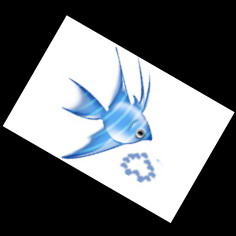

120度 150度 180度

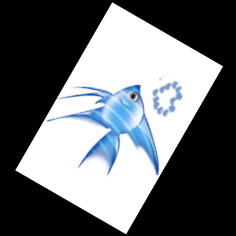

210度 240度 270度
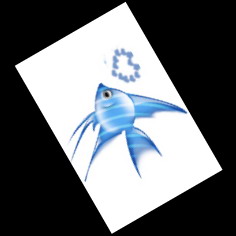


300度 330度 360度
C:用MMX指令来改进二次线性插值的旋转
{
unsigned long result;
asm
{
PXOR MM7,MM7
MOVD MM0,src
MOVD MM2,dst
PUNPCKLBW MM0,MM7
PUNPCKLBW MM2,MM7
MOVQ MM1,MM0
PUNPCKHWD MM1,MM1
PSUBW MM0,MM2
PUNPCKHDQ MM1,MM1
PSLLW MM2,8
PMULLW MM0,MM1
PADDW MM2,MM0
PSRLW MM2, 8
PACKUSWB MM2,MM7
MOVD result,MM2
}
return *(TARGB32*)& result;
}
void __declspec(naked) __stdcall BilInear_Fast_MMX(const TPicRegion& pic,const long x_16,const long y_16,TARGB32* result)
{
asm
{
mov edx,[esp+12] //y_16
mov eax,[esp+8] //x_16
PXOR mm7,mm7
shl edx,16
shl eax, 16
shr edx, 24 //edx=v_8
shr eax,24 //eax=u_8
MOVD MM6,edx
MOVD MM5,eax
mov ecx,[esp+4]//pic
mov edx,[esp+12]//y_16
mov eax,[ecx]TPicRegion.byte_width
sar edx,16
imul edx,eax
add edx,[ecx]TPicRegion.pdata
add eax,edx
mov ecx,[esp +8] //x_16
sar ecx,16 //srcx_16>>16
MOVD MM2,dword ptr [eax +ecx*4] //MM2=Color1
MOVD MM0,dword ptr [eax+ecx*4+4]//MM0=Color3
PUNPCKLWD MM5,MM5
PUNPCKLWD MM6,MM6
MOVD MM3,dword ptr [edx+ecx*4] //MM3=Color0
MOVD MM1,dword ptr [edx+ecx*4+4]//MM1=Color2
PUNPCKLDQ MM5,MM5 //mm5=u_8
PUNPCKLBW MM0,MM7
PUNPCKLBW MM1,MM7
PUNPCKLBW MM2,MM7
PUNPCKLBW MM3,MM7
PSUBw MM0,MM2
PSUBw MM1,MM3
PSLLw MM2,8
PSLLw MM3, 8
PMULlw MM0,MM5
PMULlw MM1,MM5
PUNPCKLDQ MM6,MM6 //mm6=v_8
PADDw MM0,MM2
PADDw MM1,MM3
PSRLw MM0,8
PSRLw MM1, 8
PSUBw MM0,MM1
PSLLw MM1, 8
PMULlw MM0,MM6
mov eax,[esp +16]//result
PADDw MM0,MM1
PSRLw MM0,8
PACKUSwb MM0,MM7
movd [eax],MM0
//emms
ret 16
}
}
void BilInear_Border_MMX(const TPicRegion& pic,const long x_16,const long y_16,TARGB32* result)
{
unsigned long x0=(x_16>>16 );
unsigned long y0=(y_16>>16 );
TARGB32 pixel[4 ];
bool IsInPic;
pixel[0]= Pixels_Bound(pic,x0,y0,IsInPic);
if (!IsInPic) pixel[0].a=0; else pixel[0].a=255 ;
pixel[2]=Pixels_Bound(pic,x0,y0+1 ,IsInPic);
if (!IsInPic) pixel[2].a=0; else pixel[2].a=255 ;
pixel[1]=Pixels_Bound(pic,x0+1 ,y0,IsInPic);
if (!IsInPic) pixel[1].a=0; else pixel[1].a=255 ;
pixel[3]=Pixels_Bound(pic,x0+1,y0+1 ,IsInPic);
if (!IsInPic) pixel[3].a=0; else pixel[3].a=255 ;
TPicRegion npic;
npic.pdata =&pixel[0 ];
npic.byte_width=2*sizeof (TARGB32);
// npic.width =2;
//npic.height =2;
BilInear_Fast_MMX(npic,(unsigned short)x_16,(unsigned short )y_16,result);
}
void PicRotary_BilInear_CopyLine_MMX(TARGB32* pDstLine,long dst_border_x0,long dst_in_x0,long dst_in_x1,long dst_border_x1,
const TPicRegion& SrcPic,long srcx0_16,long srcy0_16,long Ax_16,long Ay_16)
{
long x;
for (x=dst_border_x0;x<dst_in_x0;++ x)
{
TARGB32 src_color;
BilInear_Border_MMX(SrcPic,srcx0_16,srcy0_16,& src_color);
pDstLine[x]= AlphaBlend_MMX(pDstLine[x],src_color);
srcx0_16+= Ax_16;
srcy0_16+= Ay_16;
}
for (x=dst_in_x0;x<dst_in_x1;++ x)
{
BilInear_Fast_MMX(SrcPic,srcx0_16,srcy0_16,& pDstLine[x]);
srcx0_16+= Ax_16;
srcy0_16+= Ay_16;
}
for (x=dst_in_x1;x<dst_border_x1;++ x)
{
TARGB32 src_color;
BilInear_Border_MMX(SrcPic,srcx0_16,srcy0_16,& src_color);
pDstLine[x]= AlphaBlend_MMX(pDstLine[x],src_color);
srcx0_16+= Ax_16;
srcy0_16+= Ay_16;
}
asm emms
}
void PicRotaryBilInear_MMX(const TPicRegion& Dst,const TPicRegion& Src,double RotaryAngle,double ZoomX,double ZoomY,double move_x,double move_y)
{
if ( (fabs(ZoomX*Src.width)<1.0e-4) || (fabs(ZoomY*Src.height)<1.0e-4) ) return; //太小的缩放比例认为已经不可见
double tmprZoomXY=1.0/(ZoomX* ZoomY);
double rZoomX=tmprZoomXY* ZoomY;
double rZoomY=tmprZoomXY* ZoomX;
double sinA,cosA;
SinCos(RotaryAngle,sinA,cosA);
long Ax_16=(long)(rZoomX*cosA*(1<<16 ));
long Ay_16=(long)(rZoomX*sinA*(1<<16 ));
long Bx_16=(long)(-rZoomY*sinA*(1<<16 ));
long By_16=(long)(rZoomY*cosA*(1<<16 ));
double rx0=Src.width*0.5; //(rx0,ry0)为旋转中心
double ry0=Src.height*0.5 ;
long Cx_16=(long)((-(rx0+move_x)*rZoomX*cosA+(ry0+move_y)*rZoomY*sinA+rx0)*(1<<16 ));
long Cy_16=(long)((-(rx0+move_x)*rZoomX*sinA-(ry0+move_y)*rZoomY*cosA+ry0)*(1<<16 ));
TRotaryClipData rcData;
rcData.Ax_16= Ax_16;
rcData.Bx_16= Bx_16;
rcData.Cx_16= Cx_16;
rcData.Ay_16= Ay_16;
rcData.By_16= By_16;
rcData.Cy_16= Cy_16;
rcData.dst_width= Dst.width;
rcData.dst_height= Dst.height;
rcData.src_width= Src.width;
rcData.src_height= Src.height;
if (!rcData.inti_clip(move_x,move_y,1)) return ;
TARGB32* pDstLine= Dst.pdata;
((TUInt8*&)pDstLine)+=(Dst.byte_width* rcData.out_dst_down_y);
while (true) //to down
{
long y= rcData.out_dst_down_y;
if (y>=Dst.height) break ;
if (y>=0 )
{
PicRotary_BilInear_CopyLine_MMX(pDstLine,rcData.out_dst_x0_boder,rcData.out_dst_x0_in,
rcData.out_dst_x1_in,rcData.out_dst_x1_boder,Src,rcData.out_src_x0_16,rcData.out_src_y0_16,Ax_16,Ay_16);
}
if (!rcData.next_clip_line_down()) break ;
((TUInt8*&)pDstLine)+= Dst.byte_width;
}
pDstLine= Dst.pdata;
((TUInt8*&)pDstLine)+=(Dst.byte_width* rcData.out_dst_up_y);
while (rcData.next_clip_line_up()) //to up
{
long y= rcData.out_dst_up_y;
if (y<0) break ;
((TUInt8*&)pDstLine)-= Dst.byte_width;
if (y< Dst.height)
{
PicRotary_BilInear_CopyLine_MMX(pDstLine,rcData.out_dst_x0_boder,rcData.out_dst_x0_in,
rcData.out_dst_x1_in,rcData.out_dst_x1_boder,Src,rcData.out_src_x0_16,rcData.out_src_y0_16,Ax_16,Ay_16);
}
}
}
//注:测试图片都是800*600的图片旋转到1004*1004的图片中心 测试成绩取各个旋转角度的平均速度值
//速度测试:
//==============================================================================
// PicRotaryBilInear_MMX 100.2 fps
D:三次卷积插值的旋转
(实现就比较简单了,几乎就是拷贝代码,然后稍微改写几个单词:)
(很多代码从《图形图像处理-之-高质量的快速的图像缩放 中篇 二次线性插值和三次卷积插值》文章来的)
{
//该函数计算插值曲线sin(x*PI)/(x*PI)的值 // PI=3.1415926535897932385;
//下面是它的近似拟合表达式
const float a = -1; //a还可以取 a=-2,-1,-0.75,-0.5等等,起到调节锐化或模糊程度的作用
if (x<0) x=-x; //x=abs(x);
double x2=x* x;
double x3=x2* x;
if (x<=1 )
return (a+2)*x3 - (a+3)*x2 + 1 ;
else if (x<=2 )
return a*x3 - (5*a)*x2 + (8*a)*x - (4* a);
else
return 0 ;
}
inline TUInt8 ColorBound(long Color)
{
if (Color<=0 )
return 0 ;
else if (Color>=255 )
return 255 ;
else
return Color;
}
static long SinXDivX_Table_8[(2<<8)+1 ];
class _CAutoInti_SinXDivX_Table {
private :
void _Inti_SinXDivX_Table()
{
for (long i=0;i<=(2<<8);++ i)
SinXDivX_Table_8[i]=long(0.5+256*SinXDivX(i*(1.0/(256 ))));
};
public :
_CAutoInti_SinXDivX_Table() { _Inti_SinXDivX_Table(); }
};
static _CAutoInti_SinXDivX_Table __tmp_CAutoInti_SinXDivX_Table;
void ThreeOrder_Fast(const TPicRegion& pic,const long x_16,const long y_16,TARGB32* result)
{
long u_8=(unsigned char)((x_16)>>8 );
long v_8=(unsigned char)((y_16)>>8 );
const TARGB32* pixel=&Pixels(pic,(x_16>>16)-1,(y_16>>16)-1 );
long pic_byte_width= pic.byte_width;
long au_8[4],av_8[4 ];
//
au_8[0]=SinXDivX_Table_8[(1<<8)+ u_8];
au_8[1]= SinXDivX_Table_8[u_8];
au_8[2]=SinXDivX_Table_8[(1<<8)- u_8];
au_8[3]=SinXDivX_Table_8[(2<<8)- u_8];
av_8[0]=SinXDivX_Table_8[(1<<8)+ v_8];
av_8[1]= SinXDivX_Table_8[v_8];
av_8[2]=SinXDivX_Table_8[(1<<8)- v_8];
av_8[3]=SinXDivX_Table_8[(2<<8)- v_8];
long sR=0,sG=0,sB=0,sA=0 ;
for (long i=0;i<4;++ i)
{
long aA=au_8[0]*pixel[0].a + au_8[1]*pixel[1].a + au_8[2]*pixel[2].a + au_8[3]*pixel[3 ].a;
long aR=au_8[0]*pixel[0].r + au_8[1]*pixel[1].r + au_8[2]*pixel[2].r + au_8[3]*pixel[3 ].r;
long aG=au_8[0]*pixel[0].g + au_8[1]*pixel[1].g + au_8[2]*pixel[2].g + au_8[3]*pixel[3 ].g;
long aB=au_8[0]*pixel[0].b + au_8[1]*pixel[1].b + au_8[2]*pixel[2].b + au_8[3]*pixel[3 ].b;
sA+=aA* av_8[i];
sR+=aR* av_8[i];
sG+=aG* av_8[i];
sB+=aB* av_8[i];
((TUInt8*&)pixel)+= pic_byte_width;
}
*(unsigned long*)result=ColorBound(sB>>16) | (ColorBound(sG>>16)<<8) | (ColorBound(sR>>16)<<16)| (ColorBound(sA>>16)<<24 );
}
void ThreeOrder_Border(const TPicRegion& pic,const long x_16,const long y_16,TARGB32* result)
{
unsigned long x0_sub1=(x_16>>16)-1 ;
unsigned long y0_sub1=(y_16>>16)-1 ;
long u_16_add1=((unsigned short)(x_16))+(1<<16 );
long v_16_add1=((unsigned short)(y_16))+(1<<16 );
TARGB32 pixel[16 ];
long i,j;
for (i=0;i<4;++ i)
{
long y=y0_sub1+ i;
for (j=0;j<4;++ j)
{
long x=x0_sub1+ j;
bool IsInPic;
pixel[i*4+j]= Pixels_Bound(pic,x,y,IsInPic);
if (!IsInPic) pixel[i*4+j].a=0; else pixel[i*4+j].a=255 ;
}
}
TPicRegion npic;
npic.pdata =&pixel[0 ];
npic.byte_width=4*sizeof (TARGB32);
// npic.width =4;
//npic.height =4;
ThreeOrder_Fast(npic,u_16_add1,v_16_add1,result);
}
void PicRotary_ThreeOrder_CopyLine(TARGB32* pDstLine,long dst_border_x0,long dst_in_x0,long dst_in_x1,long dst_border_x1,
const TPicRegion& SrcPic,long srcx0_16,long srcy0_16,long Ax_16,long Ay_16)
{
long x;
for (x=dst_border_x0;x<dst_in_x0;++ x)
{
TARGB32 src_color;
ThreeOrder_Border(SrcPic,srcx0_16,srcy0_16,& src_color);
pDstLine[x]= AlphaBlend(pDstLine[x],src_color);
srcx0_16+= Ax_16;
srcy0_16+= Ay_16;
}
for (x=dst_in_x0;x<dst_in_x1;++ x)
{
ThreeOrder_Fast(SrcPic,srcx0_16,srcy0_16,& pDstLine[x]);
srcx0_16+= Ax_16;
srcy0_16+= Ay_16;
}
for (x=dst_in_x1;x<dst_border_x1;++ x)
{
TARGB32 src_color;
ThreeOrder_Border(SrcPic,srcx0_16,srcy0_16,& src_color);
pDstLine[x]= AlphaBlend(pDstLine[x],src_color);
srcx0_16+= Ax_16;
srcy0_16+= Ay_16;
}
}
void PicRotaryThreeOrder(const TPicRegion& Dst,const TPicRegion& Src,double RotaryAngle,double ZoomX,double ZoomY,double move_x,double move_y)
{
if ( (fabs(ZoomX*Src.width)<1.0e-4) || (fabs(ZoomY*Src.height)<1.0e-4) ) return; //太小的缩放比例认为已经不可见
double tmprZoomXY=1.0/(ZoomX* ZoomY);
double rZoomX=tmprZoomXY* ZoomY;
double rZoomY=tmprZoomXY* ZoomX;
double sinA,cosA;
SinCos(RotaryAngle,sinA,cosA);
long Ax_16=(long)(rZoomX*cosA*(1<<16 ));
long Ay_16=(long)(rZoomX*sinA*(1<<16 ));
long Bx_16=(long)(-rZoomY*sinA*(1<<16 ));
long By_16=(long)(rZoomY*cosA*(1<<16 ));
double rx0=Src.width*0.5; //(rx0,ry0)为旋转中心
double ry0=Src.height*0.5 ;
long Cx_16=(long)((-(rx0+move_x)*rZoomX*cosA+(ry0+move_y)*rZoomY*sinA+rx0)*(1<<16 ));
long Cy_16=(long)((-(rx0+move_x)*rZoomX*sinA-(ry0+move_y)*rZoomY*cosA+ry0)*(1<<16 ));
TRotaryClipData rcData;
rcData.Ax_16= Ax_16;
rcData.Bx_16= Bx_16;
rcData.Cx_16= Cx_16;
rcData.Ay_16= Ay_16;
rcData.By_16= By_16;
rcData.Cy_16= Cy_16;
rcData.dst_width= Dst.width;
rcData.dst_height= Dst.height;
rcData.src_width= Src.width;
rcData.src_height= Src.height;
if (!rcData.inti_clip(move_x,move_y,2)) return ;
TARGB32* pDstLine= Dst.pdata;
((TUInt8*&)pDstLine)+=(Dst.byte_width* rcData.out_dst_down_y);
while (true) //to down
{
long y= rcData.out_dst_down_y;
if (y>=Dst.height) break ;
if (y>=0 )
{
PicRotary_ThreeOrder_CopyLine(pDstLine,rcData.out_dst_x0_boder,rcData.out_dst_x0_in,
rcData.out_dst_x1_in,rcData.out_dst_x1_boder,Src,rcData.out_src_x0_16,rcData.out_src_y0_16,Ax_16,Ay_16);
}
if (!rcData.next_clip_line_down()) break ;
((TUInt8*&)pDstLine)+= Dst.byte_width;
}
pDstLine= Dst.pdata;
((TUInt8*&)pDstLine)+=(Dst.byte_width* rcData.out_dst_up_y);
while (rcData.next_clip_line_up()) //to up
{
long y= rcData.out_dst_up_y;
if (y<0) break ;
((TUInt8*&)pDstLine)-= Dst.byte_width;
if (y< Dst.height)
{
PicRotary_ThreeOrder_CopyLine(pDstLine,rcData.out_dst_x0_boder,rcData.out_dst_x0_in,
rcData.out_dst_x1_in,rcData.out_dst_x1_boder,Src,rcData.out_src_x0_16,rcData.out_src_y0_16,Ax_16,Ay_16);
}
}
}
//注:测试图片都是800*600的图片旋转到1004*1004的图片中心 测试成绩取各个旋转角度的平均速度值
//速度测试:
//==============================================================================
// PicRotaryThreeOrder 22.8 fps
三次卷积插值旋转结果图示:



30度 60度 90度

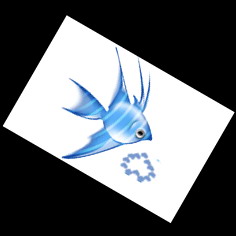

120度 150度 180度

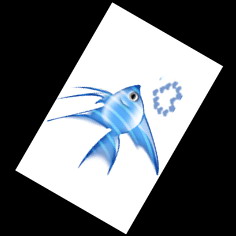

210度 240度 270度



300度 330度 360度
E:用MMX优化三次卷积插值的旋转
//注:测试图片都是800*600的图片旋转到1004*1004的图片中心 测试成绩取各个旋转角度的平均速度值
//速度测试:
//==============================================================================
// PicRotaryThreeOrder_MMX 44.2 fps
static TMMXData32 SinXDivX_Table_MMX[(2<<8)+1 ];
class _CAutoInti_SinXDivX_Table_MMX {
private :
void _Inti_SinXDivX_Table_MMX()
{
for (long i=0;i<=(2<<8);++ i)
{
unsigned short t=long(0.5+(1<<14)*SinXDivX(i*(1.0/(256 ))));
unsigned long tl=t | (((unsigned long)t)<<16 );
SinXDivX_Table_MMX[i]= tl;
}
};
public :
_CAutoInti_SinXDivX_Table_MMX() { _Inti_SinXDivX_Table_MMX(); }
};
static _CAutoInti_SinXDivX_Table_MMX __tmp_CAutoInti_SinXDivX_Table_MMX;
void __declspec(naked) _private_ThreeOrder_Fast_MMX()
{
asm
{
movd mm1,dword ptr [edx]
movd mm2,dword ptr [edx+4 ]
movd mm3,dword ptr [edx+8 ]
movd mm4,dword ptr [edx+12 ]
movd mm5,dword ptr [(offset SinXDivX_Table_MMX)+256*4+eax*4 ]
movd mm6,dword ptr [(offset SinXDivX_Table_MMX)+eax*4 ]
punpcklbw mm1,mm7
punpcklbw mm2,mm7
punpcklwd mm5,mm5
punpcklwd mm6,mm6
psllw mm1,7
psllw mm2, 7
pmulhw mm1,mm5
pmulhw mm2,mm6
punpcklbw mm3,mm7
punpcklbw mm4,mm7
movd mm5,dword ptr [(offset SinXDivX_Table_MMX) +256*4+ecx*4 ]
movd mm6,dword ptr [(offset SinXDivX_Table_MMX)+512*4+ecx*4 ]
punpcklwd mm5,mm5
punpcklwd mm6,mm6
psllw mm3,7
psllw mm4, 7
pmulhw mm3,mm5
pmulhw mm4,mm6
paddsw mm1,mm2
paddsw mm3,mm4
movd mm6,dword ptr [ebx] //v
paddsw mm1,mm3
punpcklwd mm6,mm6
pmulhw mm1,mm6
add edx,esi //+pic.byte_width
paddsw mm0,mm1
ret
}
}
inline void ThreeOrder_Fast_MMX(const TPicRegion& pic,const long x_16,const long y_16,TARGB32* result)
{
asm
{
mov ecx,pic
mov eax,y_16
mov ebx,x_16
movzx edi,ah //v_8
mov edx,[ecx+ TPicRegion.pdata]
shr eax,16
mov esi,[ecx + TPicRegion.byte_width]
dec eax
movzx ecx,bh //u_8
shr ebx,16
imul eax,esi
lea edx,[edx +ebx*4-4 ]
add edx,eax //pixel
mov eax,ecx
neg ecx
pxor mm7,mm7 // 0
//mov edx,pixel
pxor mm0,mm0 // result=0
//lea eax,auv_7
lea ebx,[(offset SinXDivX_Table_MMX) +256*4+edi*4 ]
call _private_ThreeOrder_Fast_MMX
lea ebx,[(offset SinXDivX_Table_MMX)+edi*4 ]
call _private_ThreeOrder_Fast_MMX
neg edi
lea ebx,[(offset SinXDivX_Table_MMX)+256*4+edi*4 ]
call _private_ThreeOrder_Fast_MMX
lea ebx,[(offset SinXDivX_Table_MMX)+512*4+edi*4 ]
call _private_ThreeOrder_Fast_MMX
psraw mm0,3
mov eax,result
packuswb mm0,mm7
movd [eax],mm0
emms
}
}
void ThreeOrder_Border_MMX(const TPicRegion& pic,const long x_16,const long y_16,TARGB32* result)
{
unsigned long x0_sub1=(x_16>>16)-1 ;
unsigned long y0_sub1=(y_16>>16)-1 ;
long u_16_add1=((unsigned short)(x_16))+(1<<16 );
long v_16_add1=((unsigned short)(y_16))+(1<<16 );
TARGB32 pixel[16 ];
long i,j;
for (i=0;i<4;++ i)
{
long y=y0_sub1+ i;
for (j=0;j<4;++ j)
{
long x=x0_sub1+ j;
bool IsInPic;
pixel[i*4+j]= Pixels_Bound(pic,x,y,IsInPic);
if (!IsInPic) pixel[i*4+j].a=0; else pixel[i*4+j].a=255 ;
}
}
TPicRegion npic;
npic.pdata =&pixel[0 ];
npic.byte_width=4*sizeof (TARGB32);
// npic.width =4;
//npic.height =4;
ThreeOrder_Fast_MMX(npic,u_16_add1,v_16_add1,result);
}
void PicRotary_ThreeOrder_CopyLine_MMX(TARGB32* pDstLine,long dst_border_x0,long dst_in_x0,long dst_in_x1,long dst_border_x1,
const TPicRegion& SrcPic,long srcx0_16,long srcy0_16,long Ax_16,long Ay_16)
{
long x;
for (x=dst_border_x0;x<dst_in_x0;++ x)
{
TARGB32 src_color;
ThreeOrder_Border_MMX(SrcPic,srcx0_16,srcy0_16,& src_color);
pDstLine[x]= AlphaBlend_MMX(pDstLine[x],src_color);
srcx0_16+= Ax_16;
srcy0_16+= Ay_16;
}
for (x=dst_in_x0;x<dst_in_x1;++ x)
{
ThreeOrder_Fast_MMX(SrcPic,srcx0_16,srcy0_16,& pDstLine[x]);
srcx0_16+= Ax_16;
srcy0_16+= Ay_16;
}
for (x=dst_in_x1;x<dst_border_x1;++ x)
{
TARGB32 src_color;
ThreeOrder_Border_MMX(SrcPic,srcx0_16,srcy0_16,& src_color);
pDstLine[x]= AlphaBlend_MMX(pDstLine[x],src_color);
srcx0_16+= Ax_16;
srcy0_16+= Ay_16;
}
asm emms
}
void PicRotaryThreeOrder_MMX(const TPicRegion& Dst,const TPicRegion& Src,double RotaryAngle,double ZoomX,double ZoomY,double move_x,double move_y)
{
if ( (fabs(ZoomX*Src.width)<1.0e-4) || (fabs(ZoomY*Src.height)<1.0e-4) ) return; //太小的缩放比例认为已经不可见
double tmprZoomXY=1.0/(ZoomX* ZoomY);
double rZoomX=tmprZoomXY* ZoomY;
double rZoomY=tmprZoomXY* ZoomX;
double sinA,cosA;
SinCos(RotaryAngle,sinA,cosA);
long Ax_16=(long)(rZoomX*cosA*(1<<16 ));
long Ay_16=(long)(rZoomX*sinA*(1<<16 ));
long Bx_16=(long)(-rZoomY*sinA*(1<<16 ));
long By_16=(long)(rZoomY*cosA*(1<<16 ));
double rx0=Src.width*0.5; //(rx0,ry0)为旋转中心
double ry0=Src.height*0.5 ;
long Cx_16=(long)((-(rx0+move_x)*rZoomX*cosA+(ry0+move_y)*rZoomY*sinA+rx0)*(1<<16 ));
long Cy_16=(long)((-(rx0+move_x)*rZoomX*sinA-(ry0+move_y)*rZoomY*cosA+ry0)*(1<<16 ));
TRotaryClipData rcData;
rcData.Ax_16= Ax_16;
rcData.Bx_16= Bx_16;
rcData.Cx_16= Cx_16;
rcData.Ay_16= Ay_16;
rcData.By_16= By_16;
rcData.Cy_16= Cy_16;
rcData.dst_width= Dst.width;
rcData.dst_height= Dst.height;
rcData.src_width= Src.width;
rcData.src_height= Src.height;
if (!rcData.inti_clip(move_x,move_y,2)) return ;
TARGB32* pDstLine= Dst.pdata;
((TUInt8*&)pDstLine)+=(Dst.byte_width* rcData.out_dst_down_y);
while (true) //to down
{
long y= rcData.out_dst_down_y;
if (y>=Dst.height) break ;
if (y>=0 )
{
PicRotary_ThreeOrder_CopyLine_MMX(pDstLine,rcData.out_dst_x0_boder,rcData.out_dst_x0_in,
rcData.out_dst_x1_in,rcData.out_dst_x1_boder,Src,rcData.out_src_x0_16,rcData.out_src_y0_16,Ax_16,Ay_16);
}
if (!rcData.next_clip_line_down()) break ;
((TUInt8*&)pDstLine)+= Dst.byte_width;
}
pDstLine= Dst.pdata;
((TUInt8*&)pDstLine)+=(Dst.byte_width* rcData.out_dst_up_y);
while (rcData.next_clip_line_up()) //to up
{
long y= rcData.out_dst_up_y;
if (y<0) break ;
((TUInt8*&)pDstLine)-= Dst.byte_width;
if (y< Dst.height)
{
PicRotary_ThreeOrder_CopyLine_MMX(pDstLine,rcData.out_dst_x0_boder,rcData.out_dst_x0_in,
rcData.out_dst_x1_in,rcData.out_dst_x1_boder,Src,rcData.out_src_x0_16,rcData.out_src_y0_16,Ax_16,Ay_16);
}
}
}
F 效果图:
//程序使用的调用参数:
const long testcount=2000;
long dst_wh=1004;
for (int i=0;i<testcount;++i)
{
double zoom=rand()*(1.0/RAND_MAX)+0.5;
PicRotary_XXX(ppicDst,ppicSrc,rand()*(PI*2/RAND_MAX),zoom,zoom,((dst_wh+ppicSrc.width)*rand()*(1.0/RAND_MAX)-ppicSrc.width),(dst_wh+ppicSrc.height)*rand()*(1.0/RAND_MAX)-ppicSrc.height);
}
近邻取样插值旋转效果图:
二次线性插值旋转效果图:
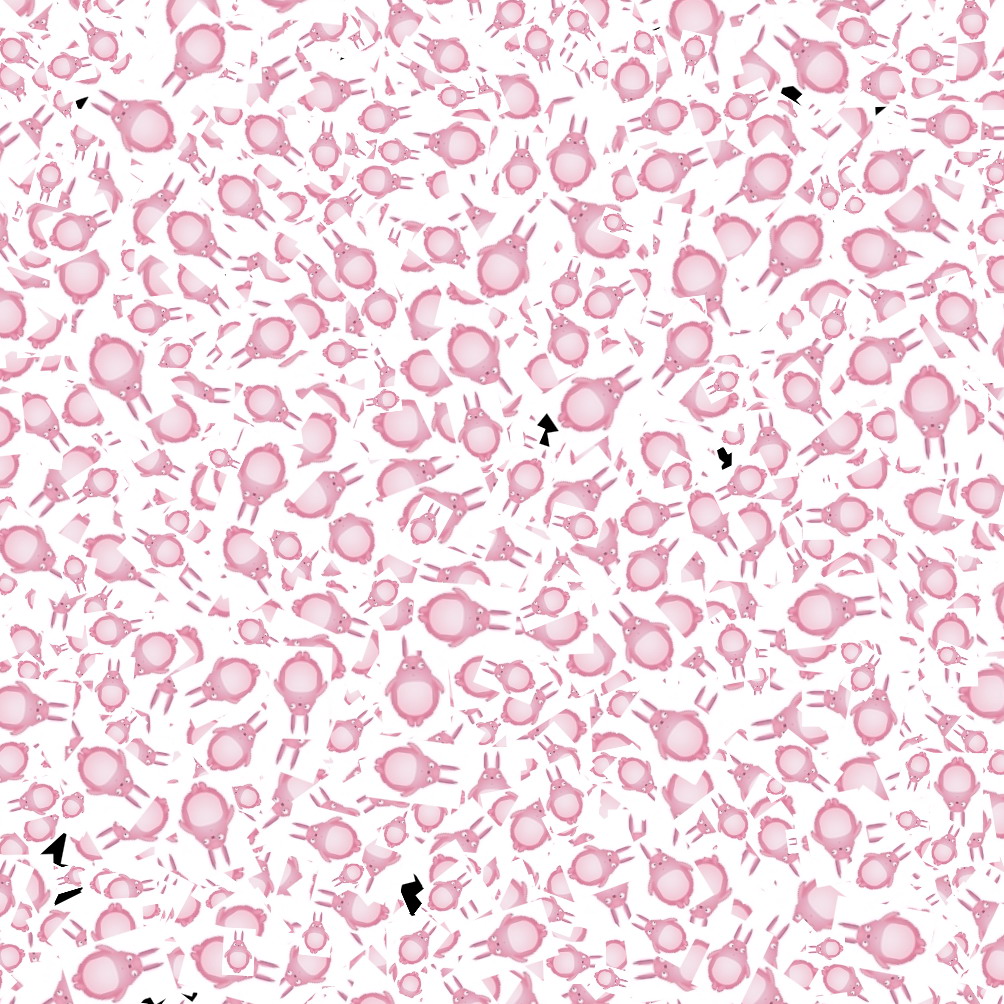
三次卷积插值旋转效果图:

G:旋转测试的结果放到一起:
//注:测试图片都是800*600的图片旋转到1004*1004的图片中心,测试成绩取各个旋转角度的平均速度值
//速度测试: (测试CPU为AMD64x2 4200+(2.37G),单线程)
//==============================================================================
// PicRotary3 280.9 fps
// PicRotarySEE 306.3 fps
// PicRotarySEE2 304.2 fps
//
// PicRotaryBilInear 68.9 fps
// PicRotaryBilInear_MMX 100.2 fps
// PicRotaryThreeOrder 22.8 fps
// PicRotaryThreeOrder_MMX 44.2 fps
补充Intel Core2 4400上的测试成绩:
//速度测试: (测试CPU为Intel Core2 4400(2.00G)单线程)
//==============================================================================
// PicRotary3 334.9 fps
// PicRotarySEE 463.1 fps
// PicRotarySEE2 449.3 fps
//
// PicRotaryBilInear 68.9 fps
// PicRotaryBilInear_MMX 109.5 fps
// PicRotaryThreeOrder 24.0 fps
// PicRotaryThreeOrder_MMX 45.9 fps
(针对大图片的预读缓冲区优化的旋转请参见《下篇 补充话题》中的优化版本)
(对于旋转的MipMap处理和三次线性插值,可以参考《图形图像处理-之-高质量的快速的图像缩放 下篇 三次线性插值和MipMap链》文章)
(这里为了函数的独立性和容易理解,都是拷贝代码然后稍作修改;实际的程序中,建议把他们合并到同一个函数中,
减少代码量,提高可维护性; 对于MMX、SSE、SSE2等的使用建议用CPUID指令测试看CPU是否支持这些指令,
动态决定调用不同的实现)
(欢迎指出文章中的错误、我没有做到的优化、改进意见 等)
更多推荐
 已为社区贡献1条内容
已为社区贡献1条内容

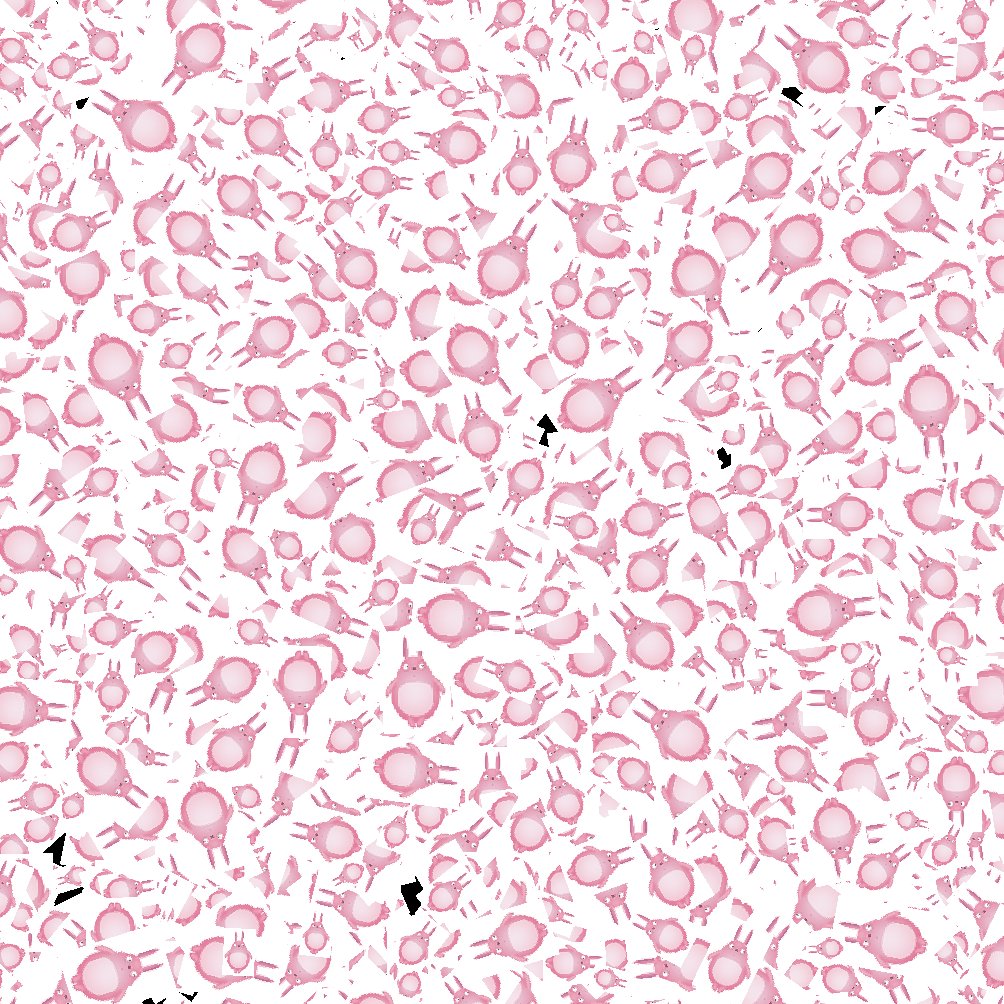








所有评论(0)